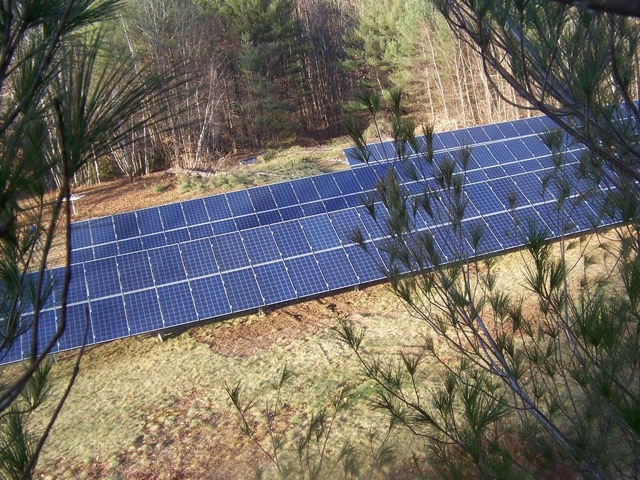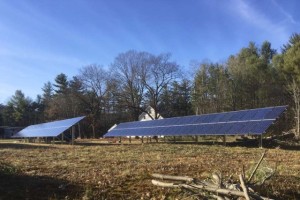The Hubbard Brook Research Foundation in Thornton/Woodstock, NH is going solar-powered. The campus, which consists of twelve buildings along Mirror Lake Road has installed a 40.6 kilowatt ground mounted photovoltaic (PV) array, expected to produce 44,700 kilowatt-hours of clean electricity each year. The commercial installation is the result of a partnership with Renewable Energy Development Associates, of Portland, Maine, who integrated the project.
The Hubbard Brook project employs a new approach to solar, allowing for more efficient siting and economy of scale. The solar array’s output is shared through New Hampshire’s neighborhood net metering program (NH RSA 362-A:9.) This program, in conjunction with the NH Electric Co-op grid, allows solar production from the Foundation’s most ideal site (about 87% efficient) to be shared across the twelve buildings at the Hubbard Brook campus, many of which have heavy shade, or non-optimal orientation. Annually, the system output is expected to provide 90-100% of the campus’s electricity from the sun.
“We are excited to be able to use the resources on our site to meet our electricity needs and contribute renewable energy to the grid. It is both an economical move and one that is consistent with the ecosystem thinking that developed right here at Hubbard Brook,” says Geoff Wilson, HBRF’s Facilities Manager. “Working with REDA’s Will Kessler has been excellent and we look forward to sharing lessons of our solar experience with the community.”
“Once installed, solar PV panels generate zero-carbon electricity, because their fuel is the sunshine” says Kessler. “The predictability of that sunshine makes the solar project an attractive investment for a business, Town, or non-profit, who avoids the volatility of the energy markets while at the same time managing their carbon footprint.” Based on the NH Electric Co-op’s environmental disclosures from 2013, the solar arrays at Pleasant View Farm will offset pollution by about 675 tons of CO2, 904 lbs. of SO2, and 586 lbs. of NOx over the first 25 years of its lifetime. It will also reduce the reliance on electricity imported from Canadian lines, which currently makes up approximately 17-18% of the NH Electric Co-op’s grid supply.
With a warming climate, New Hampshire has seen a change in customer’s electricity consumption and increasing summertime air-conditioning usage. In every year since 2000, the peak grid usage has come between 1:00 and 5:00 PM during the month of Jun, July, or August. Because the grid sees peak demand during afternoon hours in the summer, the solar PV plant contributes its generation, during the times when customer demand is greatest. This pattern is also true at the Hubbard Brook Campus, since field technicians, undergraduate researchers and scientists arrive for the field work season each May, and return to university in the fall.
There will be a system commissioning event held on Thursday, December 10th at 1:00PM, at the Pleasant View Farmhouse, located at 25 Dobson Hill Rd, in Thornton, NH. Free and open to the public.
For information about the solar integrator: REDA contact Will Kessler. tankfullofsun@gmail.com
For information about the Hubbard Brook Research Foundation, Contact Geoff Wilson. gwilson@hbresearchfoundation.org











Leave a Reply